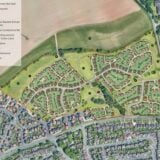Activity in the farm land market in the UK is at a low point as Brexit has led to owners outing of releasing land for sale, according to a new analysis of the sector.
In the first half of 2019 just 74,000 acres across Britain was released for sale, almost the lowest recorded acreage of publicly marketed land since 1995, says the market update report from Savills.
The exceptions were 2001 due to foot and mouth disease when just 61,000 acres were publicly marketed and 2004, the year before the single farm payment was introduced, when supply in the six month period was 74,000 acres, the same as this year.
The combination of policy change and political uncertainty is causing sellers to be more nervous than buyers but the research shows that average values across Britain have remained stable during the second quarter of this year. Savills is predicting the current stability in average values will continue while demand continues, especially for the ‘right’ farms, in a market where product is very limited.
The average value of prime arable and grade 3 grassland across the country is around £8,700 and £5,500 per acre respectively. Agents reported, however, that there is a broad range of prices achieved either side of the average, with neighbours working quickly to secure rare opportunities to acquire adjoining land and there is renewed international interest in farmland assets in well located areas.
The report also points out that the recent correction in the value of bare commercial farmland is now creating opportunities for investors to make a reasonable return, and conservation minded buyers continue to express an interest in marginal and high nature value areas.
It is important in current market conditions with so little supply available and the wide range of variables that influence prices paid to not over rely on average values, it adds.
As the industry experienced in 2003, the expected change of support regime is delaying decisions to market land, regardless of the presence of active buyers in a quiet market.
A breakdown of the figures shows that in England some 54,000 acres of farmland were publicly marketed in the first half 2019 compared with 69,900 acres in same period 2018, a decrease of 23%.
In Scotland 16,200 acres of farmland were publicly marketed in the first half 2019 compared with 23,600 acres in same period 2018, a decrease of 31% and in Wales 3,860 acres of farmland were publicly marketed in the first half 2019 compared with 7,080 acres in the same period of 2018, a decrease of 45%.
‘Although there has been limited supply in the first half of this year some buyers and sellers remain cautious, given ongoing political uncertainty. However, as the year has moved on, pragmatic sellers have applied realistic pricing strategies and have been rewarded with decent levels of interest,’ said Alex Lawson Savills director of national farms and estates at Savills.
‘Lifestyle and amenity estate buyers are frustrated by lack of stock and commercial farm buyers are more selective than before but active for the right property. The quality of the property and sensible pricing is now more important than ever before,’ he added.
According to Charles Dudgeon, director of Scottish farms and estates, it has been an unusual year in terms of a restricted supply of acres in the first six months, something not seen since 2001. ‘This confirms that in times of uncertainty decisions are delayed until the direction of travel becomes clearer,’ he said.
‘It is very apparent that a conundrum exists whereby farm purchasers want to enact their expansion plans almost irrespective of Brexit while sellers seem to find it hard to believe there is actually an active market for farmland,’ he pointed out.
The farm market has been active during the first half of this year with keen buyers looking for the right farm, according to Daniel Rees, associate director of farms and estates at Savills. ‘The supply of new farms and land has been limited and so those that have entered the market have attracted good interest,’ he explained.
‘Farms already on the market have generated new interest by lotting so as to appeal to both the lifestyle and agricultural buyers, the latter being both local and from further afield with rollover funds,’ he added.




